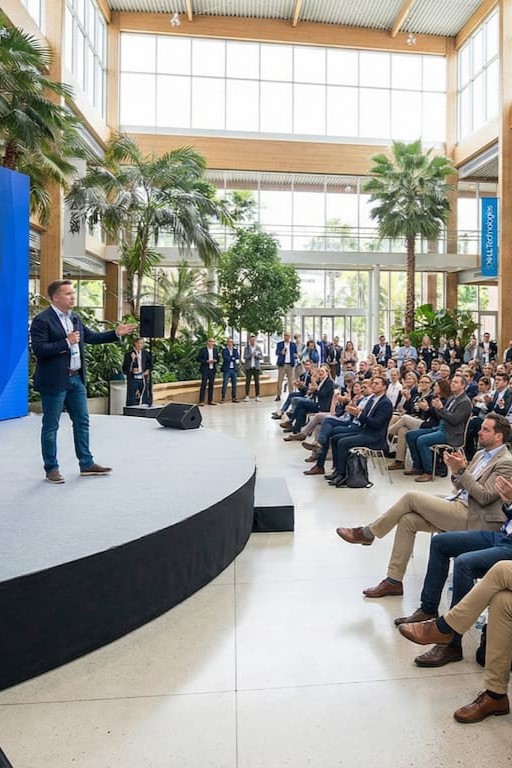Dan Charles
21/11/2025
Table of Contents

Cvent’s CEO just painted a compelling vision at CONNECT Europe: a “human-led, AI-powered, marketing-driven future” for the events industry. AI 3D event designers. Automated session insights. Tools that promise to transform how we work.
Here’s the thing – he’s absolutely right about AI becoming an expectation rather than a feature. But there’s a massive gap between what enterprise software companies are building and what event businesses actually need right now.
I’ve spent years working with event agencies, venues, and service providers. Most aren’t struggling because they lack AI-powered 3D venue designers. They’re drowning in the tedious administrative work that bleeds margins and steals time from the human connections that actually drive their business.
Key Takeaways
- AI is becoming an industry expectation rather than a differentiating feature, with attendees and clients expecting automated, efficient experiences that surface the right information at the right time.
- Enterprise AI tools address scale problems that most event businesses don’t have yet, creating a disconnect between vendor solutions and the daily operational challenges facing smaller agencies and venues.
- The highest-ROI AI applications aren’t flashy 3D designers – they’re the small, repetitive workflows that consume massive chunks of your team’s time and can be automated away completely.
- Time auditing reveals the bottlenecks where files get stuck, processes slow down, and margins erode while your team handles manual tasks instead of creating exceptional client experiences.
The Enterprise Vision vs. Event Business Reality
Reggie Aggarwal’s keynote hit all the right notes. AI as a “force multiplier.” Events delivering measurable ROI. The enduring power of face-to-face connection. With over 5,000 employees and 25,000 customers worldwide, Cvent’s building tools for their scale.
But let’s talk about what that means for the event agency with a 12-person team, or the venue trying to increase booking frequency, or the corporate event coordinator managing multiple projects with limited resources.
When Cvent showcases Session Snapshots delivering live transcripts and AI Response Assistants helping hotels respond to RFPs faster, they’re solving enterprise-scale problems. The question isn’t whether these tools are valuable – they absolutely are. The question is whether they’re solving the problems that are actually keeping event professionals from scaling their businesses and maintaining consistent revenue.
What the Data Actually Shows
Look, I get it. Everyone’s talking about AI transformation. But here’s what the research actually reveals about where event businesses are bleeding time and money:
According to industry analysis, event businesses can save up to 62+ hours per month previously lost to busywork by optimizing staffing, timelines, and basic automation. That’s not 62 hours building fancy 3D venue renders – that’s 62 hours shuffling emails, coordinating vendors, and manually processing the same information through the same steps every single time.
The global event logistics market hit $72.3 billion in 2024 and is projected to reach $125.5 billion by 2034. That’s a massive investment primarily directed at transportation, setup, management, and coordination services – the operational backbone that most event pros spend more time managing than the actual creative work that attracted them to the industry in the first place.
For major B2B events like trade shows, the average spend on logistics and related services in the US reached around $1.4 million per event in 2023 – a 70% increase from 2022. And here’s the kicker: 75% of exhibitors reported maintaining or increasing their logistics budgets even as they struggled with economic uncertainty.
Where Your Team’s Time Actually Goes
Based on industry practice and workflow analysis, here’s the brutal reality of how event teams actually spend their time:
| Workflow Component | Time Allocation | What This Actually Means |
| Logistics & Admin | 40-60% | Transportation coordination, vendor management, setup scheduling, compliance reporting, contract shuffling |
| Actual Event Execution | 20-30% | The human experience, live operations, attendee engagement – the stuff you got into this business to do |
| Post-Event Reporting | 10-20% | Feedback collection, financial analysis, wrap-up documentation |
Nobody teaches you this when you’re starting out. The industry pushes us toward this idea that if we just work harder, stay organized, and hustle through the chaos, we’ll make it work. But I learned the hard way that you can’t manually grind your way out of a systems problem.
The real issue? 19% of marketers are juggling 4-7 different technology vendors for each event. That’s not a technology problem – that’s a coordination nightmare that eats hours every single day, with each platform requiring its own login, its own quirks, its own way of doing things that doesn’t quite sync with the others.
What Event Businesses Actually Need From AI
I hear it constantly from event professionals: “AI is going to take away the human element that makes our events special.” But that’s not what’s happening at all.
Think about your typical week. How much time does your team spend shuffling emails? Building documents from scratch? Doing tedious administrative work that follows the exact same process every single time? Handling logistics that require zero creativity but consume hours of productive time?
That’s where AI should be working for you – not replacing the human experience, but giving you more bandwidth to focus on it.
Event-Led Growth isn’t a new concept, despite how enterprise software companies package it. Event professionals have known for years that in-person experiences deliver some of the highest ROI in business. According to recent industry research, optimism in the meetings and events sector is at a five-year high, with events continuing to prove their value even amid economic uncertainty.
But here’s what vendors don’t emphasize enough: events can also be massive money and time sinks when they’re treated as tick-box exercises. You’ve got to promote them effectively, fill seats with qualified attendees, and create experiences worth the investment. Without systematic marketing and lead generation, even the most beautifully designed event burns cash.
The Real Risk in “Event-Led Growth”
Cvent’s promoting Event-Led Growth as a go-to-market strategy, positioning events as central drivers of customer acquisition and revenue. They’ve even built Cvent Essentials specifically for managing small, repeatable events at scale.
The risk? Smaller event businesses and startups often don’t have the capital to execute events to the standard that’s expected these days. The gap between what enterprise companies can deliver and what smaller operations can afford is real.
The good news? AI is helping bridge that gap more effectively than ever before. But not through flashy 3D venue designers.
Where to Actually Start
If you’re reading about Cvent’s vision and feeling overwhelmed or behind, here’s what matters right now:
Start with a time audit. Look at where your team is actually spending their hours. What are the small, annoying, repetitive tasks that consume 10-20% of everyone’s time? What processes have bottlenecks where files get stuck, waiting for someone to manually move them to the next stage?
Sometimes it’s not the big shiny thing. Sometimes it’s just: we have to take this file, process it in a specific way, shuttle it over here, get it QA’d, then send it back to three people. And it gets stuck in the system for weeks because no one knows what’s happening with this particular file, but it works as a bottleneck to the entire production process.
Those annoying, tedious, repetitive, margin-bleeding, process-slowing logistics bottlenecks? That’s where you should be applying AI right now. Not because it’s revolutionary, but because it frees your team to focus on what actually matters: creating awesome events for your clients.
Don’t try to automate entire processes with some all-encompassing AI platform. It’s not ready for prime time. Instead, tackle lots of small tasks across a larger surface area. Stack those wins one at a time. Before you know it, your team has real bandwidth back.
The event businesses that are actually scaling aren’t the ones waiting for the perfect AI solution. They’re the ones who built coherent marketing systems that work together, identified where their bottlenecks actually were (not where they thought they should be), and systematically removed friction from their operations.
The Balance Between Human and AI
Aggarwal got one thing exactly right: “In a digital-first world, human connection isn’t just a nice-to-have—it’s our industry’s greatest advantage.”
But most event businesses I work with aren’t struggling with this balance because they lack the right AI tools. They’re struggling because they’re buried in logistical headaches, budget changes, seasonality swings, and economic pressures – all while trying to deliver exceptional human experiences.
The businesses that scale aren’t the ones with the most sophisticated AI platforms. They’re the ones who identified that 40-60% of operational time being consumed by logistics and admin work, figured out which pieces could be automated away, and gave their teams the space to focus on client relationships, creative execution, and the strategic positioning that actually drives bookings.
That’s the real AI revolution in events. Not replacing the human element – amplifying it by removing the administrative friction that prevents us from doing our best work.
The industry isn’t going to teach you this. Enterprise software companies are building for their scale, not yours. But you don’t need their solutions to start reclaiming your team’s time today.
Ready to identify where AI and automation can actually move the needle in your event business? Our EEPS Strategy Assessment helps event agencies and venues audit their operations and build systematic growth that works year-round, not just during peak season. Book your strategy call here.

Why Your Event Business Doesn’t Need More Martech: It Needs a Coherent Message

Universal Attribution for Event Businesses: Track Every Lead Across Any Form Tool

The 4-Phase Event Marketing Timeline System: From Reactive Panic to Predictable Revenue




